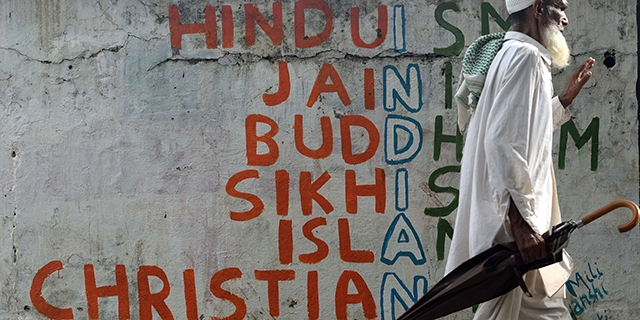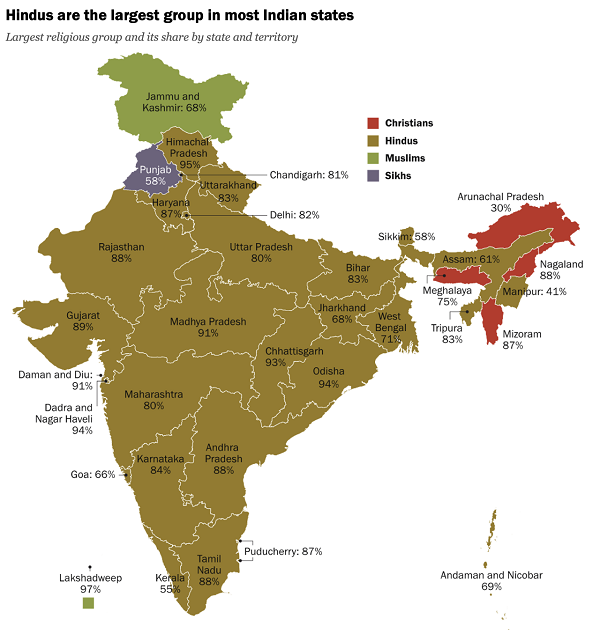'Muslims in India have higher fertility rates', reads new research report on religious composition of India
Hindus make up 79.8% of India’s population and Muslims account for 14.2%; Christians, Sikhs, Buddhists and Jains account for most of the remaining 6%
Total Views |
Religious pluralism has long been a core value in India, which has a large majority of Hindus and smaller shares of Muslims, Christians, Sikhs, Buddhists, Jains and other groups. In recent years, the size of these communities and their future growth have been topics of great interest to the Indian public.
A new Pew Research Center report shows that India’s religious composition has been fairly stable since the 1947 partition that divided the Indian subcontinent into Hindu-majority India and Muslim-majority Pakistan. This study – the second in the Center’s series about religion in India – covers the six decades between 1951, when the first post-Partition census was conducted, and 2011, the date of the nation’s most recent census. Here are some of the report’s key findings:

This Pew Research Center study describes the religious makeup of India’s population, how it changed between 1951 and 2011, and the main causes of the change. The analysis focuses on India’s three largest religious groups – Hindus, Muslims and Christians – and also covers Buddhists, Sikhs and Jains when suitable data is available. Population sizes over time come from India’s decennial census. The census has collected detailed information, including about religion, on India’s inhabitants since 1881. Data on fertility and how it is related to factors like education levels and place of residence is from India’s National Family Health Survey (NFHS). The NFHS is a large, nationally representative household survey with more extensive information about childbearing than the census.
Data on migration is primarily from the United Nations Population Division. Survey responses about religious switching (or conversion) and interfaith marriage are from a Pew Research Center survey of 29,999 Indian adults conducted in late 2019 and early 2020. India’s overall population growth has slowed considerably, especially since the 1990s. After adding the equivalent of nearly a quarter of its population every decade in the 1960s, 1970s and 1980s, the country’s growth rate dropped to 22% in the 1990s and to 18% in the most recent census decade. Growth among Hindus slowed from a high of around 24% to about 17% in the 2000s, while Muslim growth slowed to around 25% and the rate among Christians dropped to 16%.
Hindus make up 79.8% of India’s population and Muslims account for 14.2%; Christians, Sikhs, Buddhists and Jains account for most of the remaining 6%. Between 1951 and 2011, the share of Muslims in India grew modestly, by about 4 percentage points, while the share of Hindus declined by about 4 points. The shares of Indians in other religions held relatively steady. Muslims are growing somewhat faster than other groups because they tend to have more children.
ALSO READ- #OPINION- Right to Education and Minority communities in India!
Muslims in India have higher fertility rates than other groups, but they also have experienced the sharpest decline in fertility in recent decades. In 1992, the average Muslim woman had at least one more child than the average Hindu, Christian, Buddhist, Sikh or Jain. By 2015, fertility rates across all groups had fallen, with Muslims experiencing the most significant decline, from an average of 4.4 children per woman in 1992 to an average of 2.6 in 2015. Hindu women had an average of 3.3 children in 1992, a figure that fell to 2.1 by 2015. As a result of these shifts, the fertility gap between Muslim and Hindu women in India shrank from 1.1 to 0.5 children.

India is home to about 94% of the world’s Hindus. Along with Nepal, it is one of only two Hindu-majority countries, according to a 2015 Pew Research Center analysis. India is also home to one of the world’s largest Muslim populations, surpassed only by Indonesia, which had 209 million Muslims in 2010. Pakistan’s Muslim population is roughly the same size as India’s. Bangladesh follows in fourth place, with 134 million Muslims. (Modern-day Bangladesh was part of Pakistan at the time of Partition but seceded in the 1970s.) Pakistan and Bangladesh are both overwhelmingly Muslim, but the overall populations of these countries are much smaller than India’s. Overall, India has the world’s second-largest population and is expected to surpass China by 2030.
Hindus are the majority in 28 of India’s 35 states, including the most populous ones: Uttar Pradesh (total population 200 million), Maharashtra (112 million) and Bihar (104 million). Muslims are a majority in the small western archipelago of Lakshadweep (<100,000) and in Jammu and Kashmir (13 million), on the border with Pakistan. But only 5% of Muslims live in these two places; 95% live in states where they are a religious minority.

Christians form a majority of the populations of Nagaland (2 million), Mizoram (1 million) and Meghalaya (3 million) – all small, sparsely populated states in India’s Northeastern panhandle bordering China, Bangladesh, Myanmar, Bhutan and Nepal. There is only one state in which a group other than Hindus, Muslims and Christians form a majority – Punjab. About 16 million residents of Punjab identified as Sikh in the 2011 census, making this state home to most of the world’s Sikhs.
RESEARCH REPORT-
